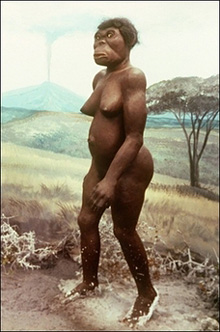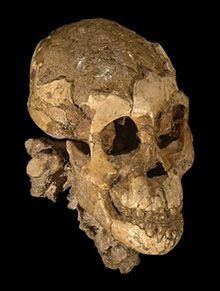 |
 |
 |
 Entertainment | September 2006 Entertainment | September 2006  
Famed Hominid 'Lucy' to Leave Ethiopia for First Exhibit Abroad
 Associated Press Associated Press


| | A full-scale model of "Lucy," the celebrated skeletal remains of a female hominid who lived 3.2 million years ago, is seen at a prehistoric museum in Bidon, France. Lucy will leave Ethiopia next year for her first-ever foreign exhibition, officials said. (AFP/File) |
"Lucy," the celebrated skeletal remains of a female hominid who lived 3.2 million years ago will leave Ethiopia next year for her first-ever foreign exhibition, officials said.

Beginning in September 2007, Lucy will enjoy top billing among 200 other Ethiopian exhibits that will tour museums in 10 US cities for four years, they said Wednesday.

"Lucy has been in Ethiopia over the last 30 years," said Gezahgen Kebede, Ethiopia's honorary consul in Houston in the US state of Texas, where the exhibition begins at the Houston Museum of Natural Sciences.

"It is time for us to share her with the whole world because she is the origin of mankind," he told AFP.

The trip will be Lucy's first overseas visit for exhibition purposes since she was discovered by American paleontologists Donald Johanson and Tom Gray in 1974 in Ethiopia's northern Afar region.

Named after the Beatles' song "Lucy in the Sky with Diamonds," she was taken once to the United States for lab tests but has remained in the country since, stored in a special vault with a replica on display at the National Museum of Ethiopia in Addis Ababa.

Gezahgen said he hoped the traveling exhibit would help alter the image of the Horn of Africa nation, which is perhaps better known to the outside world for famine, floods and other human suffering than science.

"The idea is to promote Ethiopia in a positive way," he said. "We have a lot of attractions but it is not well known abroad, where images of drought and poverty are still dominant."

Lucy, part of a hotly disputed branch of the human tree known as Australopithecus afarensis, was for more than 20 years, the earliest known member of the hominid family.

Hominids are primates who split from apes between five and seven million years ago and are considered the forerunners of anatomically modern humans, who appeared on the scene about 200,0000 years ago.

Once thought by some to be our ancestor, A. afarensis is now widely considered to be a failed branch of the human tree, for many experts suspect the hominid was anatomically far closer to apes than humans.
Skeleton Sheds Light on Ape-Man Species
Malcolm Ritter - AP


| | This photo provided by the journal Nature, shows the skull of a three-year-old Australopithecus afarensis found in Ethiopia. Scientists have discovered the remarkably complete skeleton of the 3-year-old female from the ape-man species represented by 'Lucy.' The discovery should shed light on the contentious debate about how this species moved about. The remains _ no bigger than a cantaloupe _ are 3.3 million years old, making them the oldest known skeleton of such a youthful human ancestor. (AP/Zeresenay Alemseged) |
In a discovery sure to fuel an old debate about our evolutionary history, scientists have found a remarkably complete skeleton of a 3-year-old female from the ape-man species represented by "Lucy."

The remains found in Africa are 3.3 million years old, making this the oldest known skeleton of such a youthful human ancestor.

"It's a pretty unbelievable discovery... It's sensational," said Will Harcourt-Smith, a researcher at the American Museum of Natural History in New York who wasn't involved in the find. "It provides you with a wealth of information."

For one thing, it gives new evidence for a contentious feud about whether this species, which walked upright, also climbed and moved through trees easily.

The species is Australopithecus afarensis, which lived in Africa between about 4 million and 3 million years ago. The most famous afarensis is Lucy, discovered in Ethiopia in 1974, a creature that lived about 100,000 years after the newfound specimen.

The new find is reported in Thursday's issue of the journal Nature by Zeresenay Alemseged of the Max Planck Institute for Evolutionary Anthropology in Leipzig, Germany; Fred Spoor, professor of evolutionary anatomy at University College London, and others.

The skeleton was discovered in 2000 in northeastern Ethiopia. Scientists have spent five painstaking years removing the bones from sandstone, and the job will take years more to complete.

Judging by how well it was preserved, the skeleton may have come from a body that was quickly buried by sediment in a flood, the researchers said.

"It's a once-in-a-lifetime find," said Spoor.

The skeleton has been nicknamed "Selam," which means "peace" in several Ethiopian languages.

Most scientists believe afarensis stood upright and walked on two feet, but they argue about whether it had ape-like agility in trees.

That climbing ability would require anatomical equipment like long arms, and afarensis had arms that dangled down to just above the knees. The question is whether such features indicate climbing ability or just evolutionary baggage. The loss of that ability would suggest crossing a threshold toward a more human existence.

Spoor said so far, analysis of the new fossil hasn't settled the argument but does seem to indicate some climbing ability.

While the lower body is very human-like, he said, the upper body is ape-like:

• The shoulder blades resemble those of a gorilla rather than a modern human.

• The neck seems short and thick like a great ape's, rather than the more slender version humans have to keep the head stable while running.

• The organ of balance in the inner ear is more ape-like than human.

• The fingers are very curved, which could indicate climbing ability, "but I'm cautious about that," Spoor said. Curved fingers have been noted for afarensis before, but their significance is in dispute.

A big question is what the foot bones will show when their sandstone casing is removed, he said. Will there be a grasping big toe like the opposable thumb of a human hand? Such a chimp-like feature would argue for climbing ability, he said.

Yet, to resolve the debate, scientists may have to find a way to inspect vanishingly small details of such old bones, to get clues to how those bones were used in life, he said.

Bernard Wood of George Washington University, who didn't participate in the discovery, said in an interview that the fossil provides strong evidence of climbing ability. But he also agreed that it won't settle the debate among scientists, which he said "makes the Middle East look like a picnic."

Overall, he wrote in a Nature commentary, the discovery provides "a veritable mine of information about a crucial stage in human evolutionary history."

The fossil revealed just the second hyoid bone to be recovered from any human ancestor. This tiny bone, which attaches to the tongue muscles, is very chimp-like in the new specimen, Spoor said.

While that doesn't directly reveal anything about language, it does suggest that whatever sounds the creature made "would appeal more to a chimpanzee mother than a human mother," Spoor said.

The fossil find includes the complete skull, including an impression of the brain and the lower jaw, all the vertebrae from the neck to just below the torso, all the ribs, both shoulder blades and both collarbones, the right elbow and part of a hand, both knees and much of both shin and thigh bones. One foot is almost complete, providing the first time scientists have found an afarensis foot with the bones still positioned as they were in life, Spoor said.

The work was funded by the National Geographic Society, the Institute of Human Origins at Arizona State University, the Leakey Foundation and the Planck institute.

Further information on the find:
http://www9.nationalgeographic.com/ngm/dikikababy/
Afarensis information:
http://www.mnh.si.edu/anthro/humanorigins/ha/afar.html | 
 | |
 |



